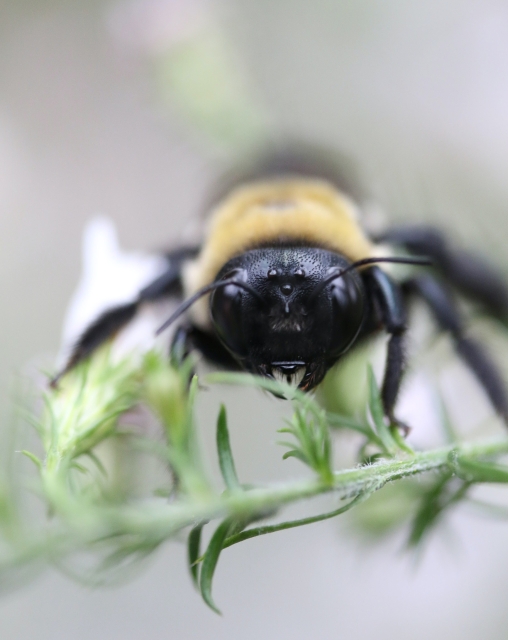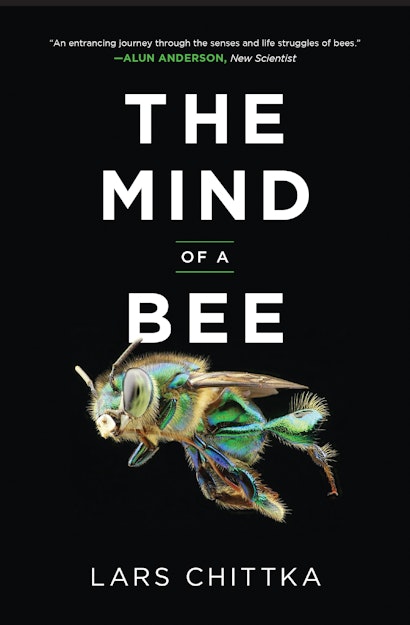Let us suppose that an inhabitant of Venus or Mars were to contemplate us from the height of a mountain, and watch the little black specks that we form in space, as we come and go in the streets and squares of our towns. All he could do, like ourselves when we gaze at the hive, would be to take note of some facts that seem very surprising; and from these facts to deduce conclusions probably no less erroneous, no less uncertain, than those that we choose to form concerning the bee. . . .
“Whither do they tend, and what is it they do?” he would ask, after years and centuries of patient watching. “What is the aim of their life, or its pivot? . . . I can see nothing that governs their actions. The little things that one day they appear to collect and build up, the next they destroy and scatter. They come and they go, they meet and disperse, but one knows not what it is they seek.
—Maurice Maeterlinck, 1901
Understanding the minds of alien life-forms is not easy, but if you relish the challenge, you don’t have to travel to outer space to find it. Alien minds are right here, all around you. You won’t necessarily find them in large-brained mammals—whose psychology is sometimes studied for the sole purpose of finding human-ness in slightly modified form. With insects such as bees, there is no such temptation: neither the societies of bees nor their individual psychology are remotely like those of humans (figure 1.1). Indeed, their perceptual world is so distinct from ours, governed by completely different sense organs, and their lives are ruled by such different priorities, that they might be accurately regarded as aliens from inner space.
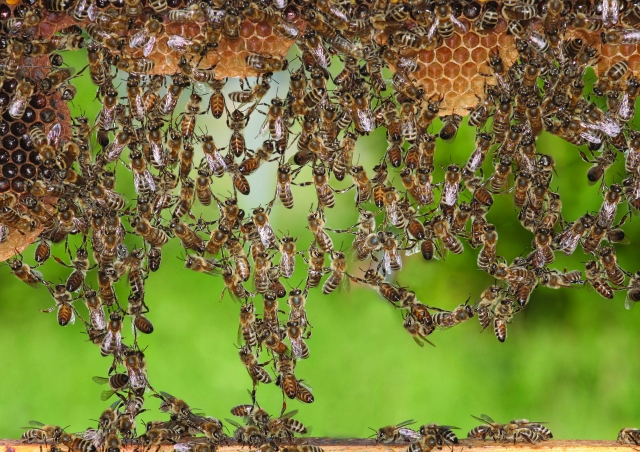
Many aspects of a bee’s life, or its communities, have no parallel in the human realm. Unique forms of sensory perception, instinctual behavior, cognition, and social interaction can give rise to structures such as the mathematically optimal honeycomb, matchless in the animal kingdom in terms of its regularity and functionality.
Insect societies may look to us like smoothly oiled machines in which the individual plays the part of a mindless cog, but a superficial alien observer might come to the same conclusion about a human society. Over the course of this book, it will be my goal to convince you that each individual bee has a mind—that it has an awareness of the world around it and of its own knowledge, including autobiographical memories; an appreciation of the outcomes of its own actions; and the capacity for basic emotions and intelligence—key ingredients of a mind. And these minds are supported by beautifully elaborate brains. As we will see, insect brains are anything but simple. Compared to a human brain with its 86 billion nerve cells, a bee’s brain may have only about a million. But each one of these cells has a finely branched structure that in complexity may resemble a full-grown oak tree. Each nerve cell can make connections with 10,000 other ones—hence there may be more than a billion such connection points in a bee brain—and each of these connections is at least potentially plastic, alterable by individual experience. These elegantly miniaturized brains are much more than input-output devices; they are biological prediction machines, exploring possibilities. And they are spontaneously active in the absence of any stimulation, even during the night.
What It’s Like to Be a Bee
To explore what might be inside the mind of a bee, it is helpful to take a first-person bee perspective, and consider which aspects of the world would matter to you, and how. I invite you to picture what it’s like to be a bee. To start, imagine you have an exoskeleton—like a knight’s armor. However, there isn’t any skin underneath: your muscles are directly attached to the armor. You’re all hard shell, soft core. You also have an inbuilt chemical weapon, designed as an injection needle that can kill any animal your size and be extremely painful to animals a thousand times your size—but using it may be the last thing you do, since it can kill you, too. Now imagine what the world looks like from inside the cockpit of a bee.
You have 300o vision, and your eyes process information faster than any human’s. All your nutrition comes from flowers, each of which provides only a tiny meal, so you often have to travel many miles to and between flowers—and you’re up against thousands of competitors to harvest the goodies. The range of colors you can see is broader than a human’s and includes ultraviolet light, as well as sensitivity for the direction in which light waves oscillate. You have sensory superpowers, such as a magnetic compass. You have protrusions on your head, as long as an arm, which can taste, smell, hear, and sense electric fields (figure 1.2). And you can fly. Given all this, what’s in your mind?
The Challenges of Being a Forager in the Wild
What is in an animal’s (including a human’s) mind is a mixture of information from its evolutionary history; information passing through the sensory filters it has acquired during evolution; information it has memorized from its experience; and things it might imagine, or anticipate. To explore the possible contents of a mind, it helps to think about what matters to the animal in question—what’s important in that animal’s daily life. For example, one thing you can be fairly sure is not on a honey bee worker’s mind is sex: worker bees are typically sterile, and female reproduction is ceded to the queen. On the other hand, flowers are likely to have a completely different significance in the mind of a bee than in our minds. Because plants can turn solar power into an energy drink—nectar—they mean survival for the individual bee and its family. Pollen—plants’ sperm—is an equally important resource to collect, since it contains high concentrations of nutritious proteins.
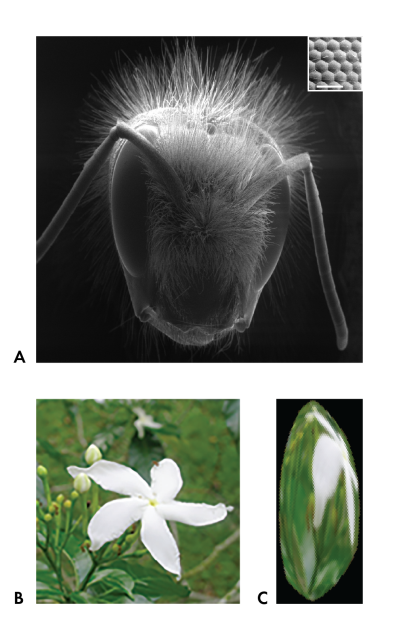
A. Electron micrograph of a bee’s head. Its antennae can sense surface textures and air currents, tastes, smells, temperature, and electric fields. The large curved eyes on both sides of the head can look in all directions simultaneously (except to the back) and possess sensitivity to ultraviolet and polarized light. These compound eyes consist of thousands of “micro-eyes” (so-called ommatidia), each with its own hexagonal lens (see inset; scale bar 50 µm), and each of which contributes one pixel to an image. B and C. An impression of how a typical star-shaped flower maps onto the bee’s curved eyes when viewed from a distance of 4 cm. Note the poor visual resolution and the strongly distorted image from this vantage point.
To explore further what plausibly could be on the mind of a creature for whom flowers mean life, imagine a young bee on its first day outside its home. The challenge is to memorize the location of home and landmarks in its surroundings, and to locate profitable flower resources. Moreover, within just a few excursions the bee would be expected to bring home a surplus, or its younger siblings will starve to death. It’s clear that our exploring bee must have a large archive of evolutionary knowledge—it does not have to learn to fly, for example, and it has an inborn knowledge that colored, scented dots in the landscape might be flowers.
However, there are many forms of information for which evolution will not have provided the bee with the necessary guidance, since a lot is unpredictable from one generation to the next. The bee does not know from birth where the flowers are, or what exactly they look like; how to manipulate them, whether they contain nectar or pollen, whether they are a good resource or poor; even if they are of good species, they may have already been depleted by competitors. All these things need to be explored and learned by each individual bee. In other words, a bee has to learn a lot in its short adult lifetime of perhaps three weeks, or it will neither find its way home nor become an efficient flower forager.
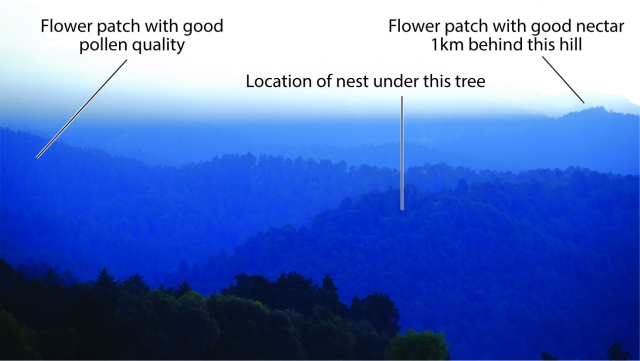
Unlike urban environments (which often contain unique landmarks designed to be recognizable), natural habitats such as forested hills are often replete with repetitive shapes and patterns that offer no particularly memorable features. Yet bees navigate successfully over many miles in such environments, remembering not just the location of their home, but also those of multiple flower foraging patches that can be rewarding at different times of day. Many humans, if forced to operate in such environments without modern technology, maps, or help from knowledgeable guides, might fail such spatial challenges.
A bee’s first flight is the most dangerous. In bumble bees, up to 10 percent of foragers never return to their native colonies after departing for the first time. Some fail the challenge of accurately remembering the home location; others fall victim to insectivorous birds or sit-and-wait flower predators such as crab spiders. To appreciate the nature of the challenge, imagine human children in this situation. To roughly match the endowment of a few-days-old novice forager bee, let’s assume our experimental children are already a few years old (say six years, so of school age). You release them into a wild environment—that is, one without purpose-built, memorable landmarks such as buildings (figure 1.3). Let’s make things simpler for the children and keep our environment predator-free. Their only instruction is to bring back food that, like a bee’s food, is perhaps up to five kilometers away from home. They need to have the forethought to take sufficient provisions to survive the trip, and when they run out, the resourcefulness to find their own. To match the complexity of floral structures, let’s assume that the food needs to be extracted from a variety of puzzle boxes whose mechanics must be figured out by the children themselves, without any instructions from adults. Then, without the assistance of well-meaning passersby, they must find their way home. How many do you think you would see at the end of the day who would also be carrying a significant surplus of food?
It is clear that those few who might succeed would be the ones with extraordinary spatial memory, good searching and motor learning abilities, and fine judgments of the quality of various resources. Over the next few days, some individuals may get better and better: having remembered the most profitable vending machines, they will focus on exploiting these (and recognizing others like them), and will also find shorter paths to connect the best locations. But things won’t be entirely stable. Let’s introduce some competition from a different group of children, and also some unpredictable changes, as in the flower world: a previously profitable location vanishes and new ones emerge, requiring further exploration. These are just a few of the basic challenges that a bee faces, and that therefore might occupy her mind. In the following sections, we will learn that these challenges require many forms of complicated decision making and efficient memory organization.
The Mind of a Shopper in the Flower Supermarket
Flowers are, essentially, plants’ sex organs, and their colors, patterns, and scents are designed to lure animals into a sexual transaction that many plants, given their lack of mobility, cannot accomplish without help: the transfer of pollen from male flower parts to female ones. But bees don’t usually provide this service for free; they need to be rewarded for their efforts. From this perspective, pollination systems may be viewed as biological markets in which animals choose between “brands” (flower species) on the basis of their quality (sugar content of nectar, for example) and plants compete for “customers” (pollinators). Bees learn the advertisements that flowers display and link them to the quality of the product each flower contains. The offerings of this market are constantly in flux: a flower patch that was rewarding in the morning may cease to yield nectar by lunchtime, or may have been depleted by competitors. It may be rewarding again at the same time the next morning, but then have withered altogether three days later. Foraging bees need to update their information in light of these changes and juggle exploitation with prospecting for alternative sources.
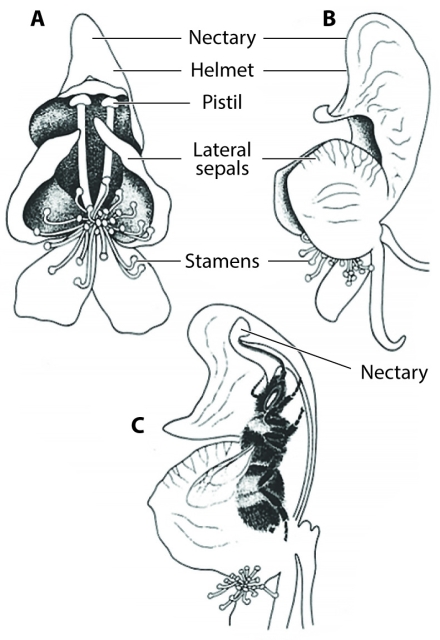
A. frontal view and B. lateral view of monkshood flower (Aconitum variegatum); and C. A bumble bee inside the flower, inserting its tongue overhead into the “hood” of the flower to extract nectar. Naïve individuals often fail to locate the nectar, and even those that succeed take dozens of visits to hone the technique.
Much of the workings of the bee’s mind can be understood only when one considers the natural challenges of the constantly changing market economy in which it must operate. The pressures of operating in this setting are often expressed in terms of physical performance. For example, a bee can carry its own body weight in nectar and/or pollen; it may need to visit 1,000 flowers and fly 10 kilometers to fill its honey stomach only once; and 100 such trips may be required to generate a teaspoon of honey. Less appreciated are the mental efforts required along the way: in visiting 1,000 flowers, the bee has to work 1,000 floral “puzzle boxes” whose mechanics can be as complicated as operating a lock (figure 1.4), and no two flower species are quite alike in the mechanics that have to be learned to gain access to their contents. While flying through a flower meadow, the bee is constantly bombarded with stimuli (color patterns, scent mixtures, electric fields) from multiple flowers of several species per second, requiring the bee to pay attention only to the most relevant stimuli and to suppress the rest. Between visits to 1,000 flowers, the bee may have to reject 5,000 other flowers that either are unfamiliar or have been found to be poorly rewarding, or only rewarding at a different time of day (figure 1.5).
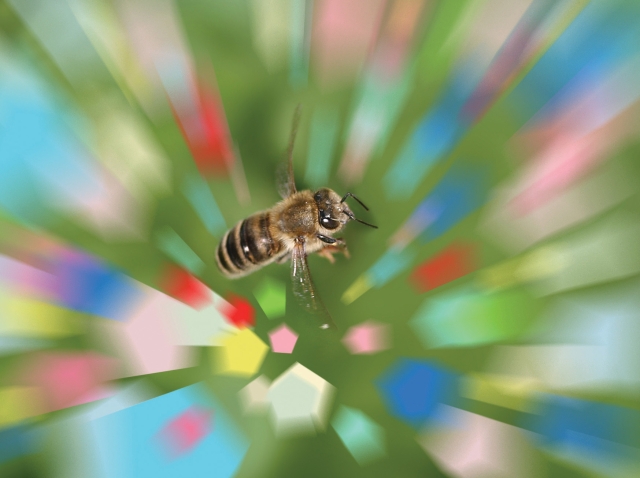
A bee flying over a flower meadow is faced with a bewildering tapestry of sensory stimuli, such as the colors and scents from multiple flower species. Like a human shopper, the bee must identify those flower species (“products”) that deliver the best cost/benefit ratio (i.e., the best nectar and pollen rewards after the efforts to reach these rewards are considered). She must memorize these flowers’ advertisements (e.g., their color, shape, and scent) and focus her attention on just these flower species, avoiding distraction from other flower signals.
While foraging, the bee also has to overcome the frustration and the starvation risk of finding dozens of empty flowers in a row that a competitor has recently emptied, and she must decide when to cut her losses and explore for an alternative food source. As she keeps visiting several thousands of flowers a day, rules begin to emerge; for example, are bilaterally symmetrical flower species (such as snapdragons) more rewarding than radially symmetrical ones (such as daisies), irrespective of species and color? Learning rules is not typically regarded as within the reach of an insect mind, but as we will soon discover, the pressures of operating in the flower supermarket have given rise to such intelligent operations in the bee. What’s more, while figuring out all these contingencies, she also has to dodge attacks from predators, and remember and avoid flower patches where predation risk is especially high. She has to keep track of the location of her home no matter how convoluted her flight path, and in the face of wind gusts that might displace her far from her established route.
Complex Decisions, Communication, and Construction at Home
Finally, upon her return home, the bee might find that a bear is digging up her nest. What to do? Should she first unload her forage, or attack the bear and risk being killed? Should she buzz around the bear’s head in a menacing way in the hope that this will suffice as a deterrent? Or should she slyly wait on a nearby tree until the attack is over? You might think that these choices are decided by innate priorities, but individual bees can choose differently according to their own predispositions.
After the bear is gone, nest repairs are needed in addition to replacing stolen honey. Building honeycomb requires the construction of precisely hexagonal cells from slivers of soft material that emerge from the abdomen, the cells sized roughly to fit around a bee’s body. For unknown reasons, this task involves forming hanging chains of bee workers (figure 1.1). Bees have to hold hands with their sisters, suspended in midair, while repair work continues around the clock.
Night or day, it is always dark in a typical western honey bees’ nest (one undamaged by a bear, that is), and the world inside is no less fascinating and strange than a bee’s outside world. Imagine a 100-story windowless skyscraper, as packed with people as a bus during rush hour. All main surfaces are vertical, and individuals are constantly scurrying up and down walls. How does any individual know what to do, among the dozens of tasks that need to be taken care of by the colony as a whole?
Much of bee communication works by pheromones (cocktails of chemicals released by multiple glands distributed over the body—fifteen in the case of the honey bee) and by electrostatic signals bees can generate, which they sense with mechanosensory hairs. But honey bees can also communicate about flower locations using symbolic movements: a strange motor display called the dance language. A forager performs a solo dance on a vertical wall. Imagining you are a bee, you and several other bees try to decipher from the dancer’s moves where she has found a food bonanza. It’s dark, so to read her movements, you have to touch her throughout her dance. A bee does this by putting its feelers on the dancer’s abdomen and holding them there while the dancer turns and shimmies. To add an evolutionary perspective, imagine your life depended on how well you could sense and interpret the dancer’s movements. Some of us would do better on a dark dance floor than others. Some would fail altogether. Some individuals might have a knack for communicating via dances in the dark and be pretty good at it right away; others would be more adept at learning to communicate this way. In time, over many generations, there would be selection both for particularly efficient ways of encoding messages in dances, and for aptitude in tactilely deciphering the code.
Why Imagining Other Minds Is Important for Understanding them
Some philosophers may argue that there is no point in trying to imagine such strange alternative worlds. I disagree; I think that it’s tremendously useful. I cannot precisely imagine what it’s like to be you (much less any other animal), but I can do it a little bit, knowing you. I cannot imagine whether you see red the same way I do, but I can check the extent to which you and I agree on calling the same things red, and the extent to which we each discriminate between two similar shades of red (which a bee cannot do). I can also imagine what it’s like to have reduced sensory powers (it happens when I take off my glasses, or when I am feeling my way around a dark cellar and have to use my tactile sense to compensate for the lack of vision), and I can imagine, a little bit, what it’s like to have a sensory superpower, such as X-ray vision. If I did, it would certainly be accessible to experimentation—for example, you could measure how thick a wall my vision could penetrate, whether I could detect the color of someone’s clothes through a wall, and so on. Such tests of what another being can perceive help us to imagine its world a little better.
The question that so puzzles some philosophers—is it unknowable what it’s actually like to be some other animal?—is probably relatively pointless. After all, it feels entirely unspectacular to live in an alternative sensory world once you get used to it. Only the transition of acquiring a new sensory ability, if we could do so, would feel exciting; but it would lose its strangeness quite quickly, and then it would feel normal. Sensory perceptions only become subjective experiences in any meaningful sense if they are attached to emotional experiences—in a bee’s case, perhaps, her reactions to finding a food bonanza, escaping a crab spider attack, or seeing her nest ripped apart by a large mammal. We will learn that bees have mind states that, by the same criteria applied to domestic and wild animals, would certainly qualify as “emotion-like states.”
To explore what it might feel like to experience life from any animal’s perspective, understanding what is important for that animal, as we have done above, is a necessary starting point. If we grasp that animals such as bees perceive the world through entirely different sensors than ours, and that different aspects of the environment are relevant for their well-being and survival, then we can unleash our imagination, immunized against the risks of anthropomorphizing—inappropriately reading human-like psychology into animals’ behavior.
Which Bees?
When contemplating bees, most of us think of social species, most prominently the domesticated western honey bee, Apis mellifera. Indeed, much of what we know about the psychology of bees has been studied in this ubiquitous species and a handful of other social species, such as bumble bees. Their social lives come with fascinating aspects of psychology. For example, they employ highly complex communication systems that ensure the efficient division of labor inside the colony to provide adequate nutrition, climate control, and colony defense. Yet only a few hundred of the world’s 20,000+ bee species are social, and the biology and behavior of the many solitary species are no less fascinating. These bees, too, provide for their young and build a home for them—but they are single working mothers, for their males, just like those of social bees, are good only for sex. Solitary females face many of the same learning tasks as social bees—for example, acquiring the spatial memory for home, and learning the appearance and handling techniques of various flowers. Solitary bees face the additional challenges of being “jacks-of-all-trades”: while social bees can allocate tasks to groups of specialists, solitary bee mothers must do it all themselves: locate suitable nesting locations, construct nests, defend them from parasites and predators, and provision the brood. However, I will not attempt comprehensive coverage of the literature on the psychology of these many species of bees. Instead, my focus will be on informative examples from across the world of bees.
Road Map of the Book
The book is structured as follows. This introduction is followed by an overview of the bees’ sensory toolkit (chapters 2 and 3). This is important because all the information that is stored in a bee’s mind must first pass through its sense organs—and we will discover shortly that the sensory world of bees is not only wholly different from that of humans, but also quite possibly richer. However, not everything that is in an animal’s (including a human’s) mind is individually acquired: our instincts govern, at least in part, what we desire, what we fear, how we perform certain movements, and so on. Chapter 4 is about the diverse repertoire of bees’ innate behaviors, and the extent to which these govern their psychology and learning behavior. Following this, in chapter 5 we explore how the roots of bee intelligence can be sought in their lifestyle as central place foragers (i.e., those that have a home to return to). Bees’ ancestors had already switched from a vagabond lifestyle to one in which adults built nests where they protected and provisioned their offspring, and this required a keen spatial memory to ensure that the location of the nest could always be found even after long-distance excursions. Chapter 6 contains a detailed exploration of how bees’ minds represent space.
In chapter 7 we learn how the habit of flower visitation drove bees to be the intellectual giants of the insect world; how, beyond the basic need to learn flower locations, colors, and scents, bees also learn rules and concepts over their lifetime that help them exploit flower resources efficiently. Chapter 8 turns to bee social learning. Bees can learn a surprising amount of information from observing peers, including which flowers to visit, but also how to solve complex object-manipulation tasks. Accordingly, many complex social behaviors are much more driven by individual problem solving than by a diffuse swarm intelligence, as was traditionally thought.
Having covered the ground from sensory input to complex social cognition, in chapter 9 we explore how the miniature nervous system of bees can support such stunning complexity. Chapter 10 focuses on psychological differences between individual bees, and their neural underpinnings. In chapter 11, we draw on evidence from all the preceding chapters and ask perhaps the most difficult question: Are bees conscious? Given that the answer is most likely “yes,” we end in chapter 12 with ethical considerations relating to bee conservation, as they emerge from our explorations of subjective experiences and the likelihood of at least a basic emotional life in bees.
A Historical Framework
Bees, and the sweets they provide, have been with humans right from the beginning of our evolutionary history. Our closest relatives among the apes consume honey and use tools for its extraction from wild bee colonies. It is therefore eminently plausible that the earliest hominins did the same. Prehistoric cave painters on several continents immortalized the raiding of bee colonies, and the members of many extant hunter-gatherer tribes extract honey from multiple species of wild bees. Honey is the most carbohydrate-rich energy drink that nature has to offer, and some scientists now believe that the practice of efficient honey collection might have fueled the evolution of our energy-hungry brains.
But, as many creative persons will testify, sugar is not all that’s required to fuel the generation of bright ideas. And indeed bees provided for inebriation, too: mead, made from fermented honey, is one of the oldest alcoholic beverages. Mead has been consumed for at least 9,000 years, in countries as far apart as China, Finland, Ethiopia, and pre-Hispanic Mexico. And candles made from beeswax lit up the night (and scholars’ desks, and temples) for many millennia before the advent of electric light.
Given the long-standing relationship between humans and bees, it is perhaps unsurprising that there is a vast body of scholarly work about the behavior of bees. During research for this book, I have enjoyed browsing the historic literature on the topic, such as the works of the blind Swiss scholar François Huber, who reported, around the turn of the eighteenth to nineteenth century, on the possibility that planning abilities were involved in the comb construction of honey bees, as well as on interindividual “personality” variation, by which he sought to explain labor division in the colony. Another inspiring story is that of the African American scientist Charles Turner (1867–1923), who performed pioneering experiments on the psychology of bees and other insects while working against impossible odds, as a high school teacher without access to scientific laboratories or libraries.
Some of this historical literature is so little known by today’s scientists that unearthing it is as exciting as if these discoveries had been made in one’s own laboratory. Throughout the book, I have provided a historical context to more-recent findings, and we will see that many seemingly contemporary ideas about the minds of bees had already been expressed, in some form, over a century ago. Since our scientific forebears were often also excellent writers, with styles less dry and jargon-y than many of today’s scholars, I will give you tastes of these historic writings, in the hope that this will inspire you to explore the original works. I have also dedicated space to describing at least some biographical details of the scholars whose breakthroughs have inspired me. This is because no scientist operates in a vacuum: it is often important to understand, for key discoveries as well as important errors, the times and circumstances in which these scientists operated and who influenced them.
Come with me on this journey into the minds of bees. We begin with their alien sensory world.
This essay is an excerpt from the introduction to The Mind of a Bee by Lars Chittka.
Lars Chittka is professor of sensory and behavioral ecology at Queen Mary University of London. He is the coeditor of Cognitive Ecology of Pollination.
Illustration Credits
1.1. Photo by Helga Heilmann: figure 1 in Gallo, V., Chittka, L. 2018. “Cognitive aspects of comb-building in the honeybee?” Frontiers in Psychology 9: 900. DOI: 10.3389/fpsyg.2018.00900.
1.2. A. Electron micrograph by Johannes Spaethe.
1.2. B and C. Images by Andrew Giger.
1.3. Photo by Lars Chittka.
1.4. Reprinted from figure 1 in Animal Behaviour, Vol. 36, Laverty, T. M., Plowright, R. C., “Flower handling by bumblebees—a comparison between specialists and generalists,” 733–40. Copyright 1988, with permission from Elsevier.
1.5. Photo and image design by Helga Heilmann, published as the cover image to the article: Roper, M., Fernando, C., Chittka, L. 2017. “Insect bio-inspired neural network provides new evidence on how simple feature detectors can enable complex visual generalization and stimulus location invariance in the miniature brain of honeybees.” PLOS Computational Biology 13 (2): e1005333.
